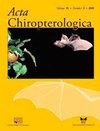雄性化学信号在大短鼻果蝙蝠鞘翅目中招募雌性
IF 0.7
4区 生物学
Q4 ZOOLOGY
引用次数: 0
摘要
通过化学信号吸引配偶在群居哺乳动物中很常见。在更大的短鼻果蝙蝠——鞘翅目鞘翅目蝙蝠中,目前尚不清楚雄性是否使用化学信号来吸引雌性。在这里,我们使用实地观察来描述该物种雄性化学信号的模式,然后使用圈养条件下的偏好测试来推断化学信号的功能。我们观察到,雄性在用唾液标记它们的叶子“帐篷”栖息地后,通过扇动翅膀进行化学信号。雄性交替有力地扇动每只翅膀,并频繁地用舌头拍打翅膀膜。这种行为表现在返回帐篷的雌性身上。之后,雄性用两只翅膀拥抱雌性。翅膀扇动和帐篷标记在交配季节比非交配季节更常见。为了推断化学信号在招募女性中的作用,我们进行了两种不同的选择测试。在第一次测试中,我们测试了与没有任何同种气味的对照帐篷相比,雌性是否更喜欢在雄性的斜肌腹侧轻轻反复摩擦的装有棉球的帐篷。在第二项测试中,我们测试了雌性是否更喜欢有雄性唾液标记的帐篷,而不是没有这些标记的对照帐篷。这两项测试的结果都表明,雌性能够识别雄性翅膀上的唾液和“气味”,因为雌性总是比对照更喜欢带有雄性化学信号的帐篷。我们的研究结果表明,大短鼻果蝙蝠雌性的招募和随后后宫的形成受到雄性化学信号的影响。本文章由计算机程序翻译,如有差异,请以英文原文为准。
Male Chemical Signalling to Recruit Females in the Greater Short-Nosed Fruit Bat Cynopterus sphinx
Mate attraction via chemosignalling is common in group-living mammals. In the greater short-nosed fruit bats, Cynopterus sphinx, it remains unclear whether males use chemosignals to attract females. Here, we use field observations to describe patterns of male chemosignalling in this species, then use preference test in captivity to infer the function of chemosignals. We observed that males engage in chemosignalling through wing fanning after marking their leaf ‘tent' roosts with saliva. The male fanned each wing alternatively and vigorously and performed frequent tongue flicks to the wing membrane. Such behaviour is exhibited towards females that returned to the tent. Afterwards, the male embraced the female with both wings. Wing fanning and tent marking occurred more often during the mating season than the non-mating season. To infer the role of chemosignals in recruiting females, we performed two different choice tests. In the first test, we tested whether females preferred the tent containing cotton balls that were rubbed gently and repeatedly on the ventral side of the plagiopatagium of the male, versus a control tent without any conspecific odour. In the second test, we tested whether females preferred a tent that was marked by a male's saliva versus a control tent without such markings. The result of both tests indicated that females recognized the saliva and ‘scent’ from the wings of males, since females always preferred tents with male chemosignals over the controls. Our findings suggest that the recruitment of females and subsequent formation of a harem in the greater short-nosed fruit bats is influenced by male chemosignals.
求助全文
通过发布文献求助,成功后即可免费获取论文全文。
去求助
来源期刊

Acta Chiropterologica
生物-动物学
CiteScore
2.50
自引率
20.00%
发文量
42
审稿时长
>12 weeks
期刊介绍:
Acta Chiropterologica, published by the Museum and Institute of Zoology at the Polish Academy of Sciences, is devoted solely to the study and discussion of bats.
 求助内容:
求助内容: 应助结果提醒方式:
应助结果提醒方式:


